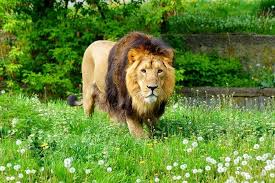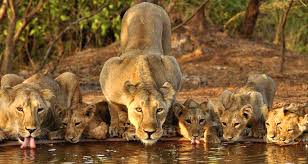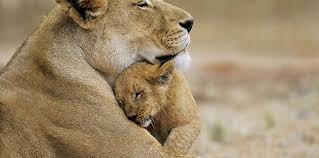 Saving Asiatic lion from extinction
Saving Asiatic lion from extinction
The Gir National Park and wildlife sanctuary is located in the Junagadh district of Gujarat. It is one of the finest wildlife sanctuaries in India. It is internationally acclaimed for successfully saving this precious species from the brink of extinction. The national park lies amid an area of 1412 square km of lush deciduous forests. This national park was established on 18 September 1965 as a Forest Reserve to conserve the Asiatic lion. This sanctuary is the final refuge of the rare Asian lions which roamed freely two centuries ago throughout Middle East and some parts of India. Sasan, with a forest rest house, is the headquarters of the sanctuary.
Various deciduous forests, grasslands, acacia scrub, wetlands and the seven rivers form the topography of this wildlife sanctuary. It has a topography made up of succession of rugged ridges, isolated hills, plateaus and valleys. Besides, being the last abode of Asiatic lions, Gir forms a unique habitat for ratel, rusty spotted cat, pangolin, ruddy mongoose, civets, paradise flycatcher etc.
The overwhelming presence of the omnipotent big cat diverts the attention of the common man from the remarkable bird population that the sanctuary has. However, the birds of Gir sanctuary did attract the great ornithologist, Dr Salim Ali who believed that, had the Asiatic lions not been there, the area would have been one of the most fascinating bird sanctuaries of the country.
Hunting lions; British pastime: Since 1884, Gir National Park has been the only habitat of the Asiatic lion. During British Raj, lions were hunted mercilessly by the British officers assisted by the obliging Maharajas and Nawabs. Every Maharaja was proud of the number of lions or tigers he killed during his lifetime. In 1899 the famine decreased the lion population so badly that Lord Curzon cancelled his shoot in Gir where he had been invited by the Nawab for a ‘Shikaar’.
Lord Curzon advised the ruler to protect the remaining lions. By the time India achieved independence, the number of lions got increased, but they were once again hunted by the Maharajas. The Government of India banned the hunting of lion in mid 1960 and now this park is open only for the photo safaris. The Gir National Park later became a major tourist attraction in India. About 300 lions are present in this park.
Wildlife attractions: The main wildlife attraction in the Gir National Park is the lion. Besides lion, variety of wild animals are found in this park among which are the wild boar, bear, panther, jackal, Sambar, spotted deer, striped hyena, leopard, Nilgai, Chinkara gazelle, jungle cat, black napped hare, common Langur, porcupine, Langur, blackbuck, mongoose and the Indian Chousingha, the four horned antelope.
During Monsoons, about 200 varieties of birds can be seen in this park including the peafowl, grey partridge, Bonelli’s eagle, crested serpent eagle, jungle bush quail, painted sandgrouse, common green pigeon and several species of doves. Gir is also home of the marsh crocodile, which can be sighted easily in its rivers, particularly in the lake of the Kamaleshwar dam. There is also a crocodile breeding farm at Sasan.
Jungle safari: You can visit the Gir National Park by having a jeep ride with a guide. The Gir Forest Department also organizes “Lion Shows”. They make sure that you can see the lions at close range so they send trackers early morning on a mission to the located places and tempt them with live baits.
Best time to visit: The Gir National Park is open from mid October to mid June. November, January and February are the best months to visit the sanctuary. However the best time to view the lions, in their natural surroundings, is early in the morning or after 4 pm. It is during this time that the animals are most active and can be easily spotted.
Other attractions: Within the Gir National Park, the Kankai Mata temple and Tulishyam Hot Springs are located in a scenic surrounding. These are the natural hot springs where one can take bath. It is about 90 km. from the entrance to the sanctuary. The forest is also known for its cattle herders, the Madharis, whose buffaloes form a substantial part of the lion’s meals.
How to reach
By air: The nearest airport is located at Keshod.
By rail: The nearest railway station is Junagadh. This station is located on the Ahmedabad – Junagadh and Rajkot – Junagadh line.
By road: Gir National Park is connected to various cities in Gujarat. Junagadh is about 60 kms from the Gir National Park.







